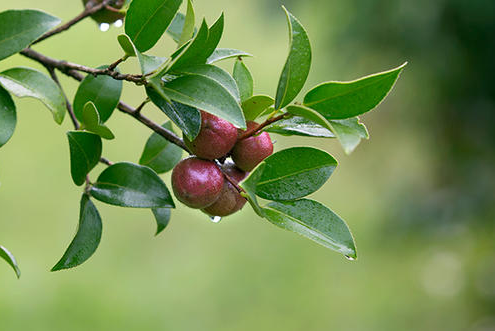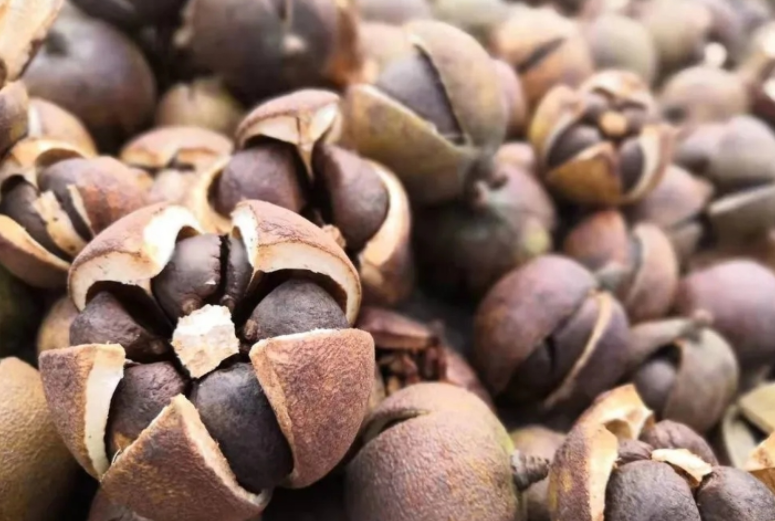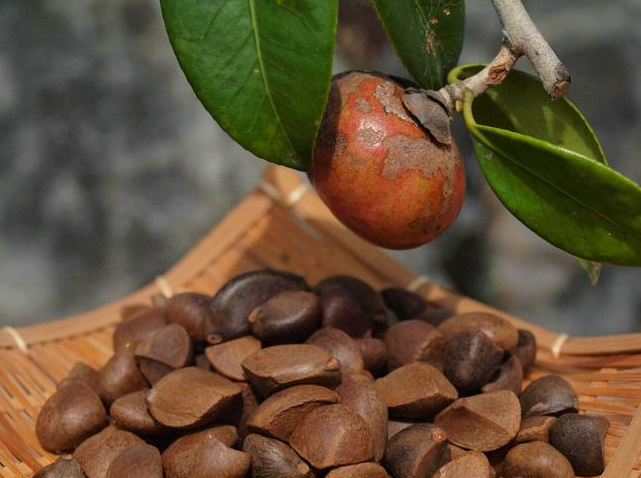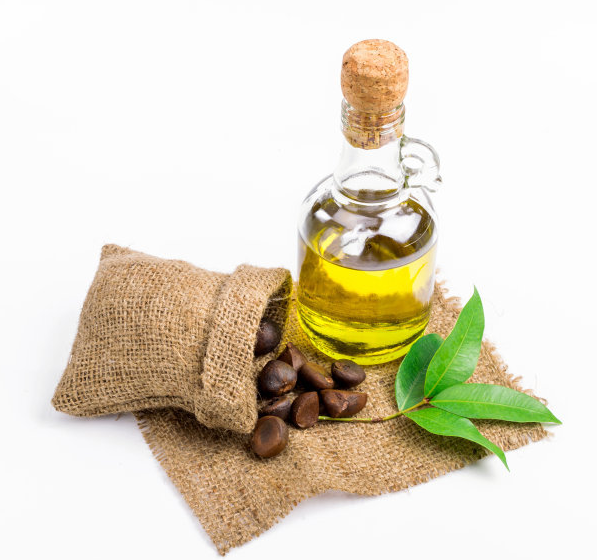The commonly used techniques for extracting camellia oil are squeezing and leaching. The squeezing method uses physical squeezing to extract camellia oil from camellia seeds, which is a traditional extraction process; the extraction method uses the extraction principle and uses food-grade solvents to extract camellia seeds from the oil. A method of extracting camellia oil is currently the most advanced extraction process recognized internationally. The pressing method is divided into cold pressing and hot pressing according to the process temperature. The cold pressing method has an oil pressing temperature of 60 degrees, while the hot pressing method has a high temperature steaming and frying, and the oil pressing temperature reaches 150 degrees. Nowadays, many companies generally adopt the complementary method of the above two methods. That is, after the oil-tea camellia seeds are squeezed to obtain "squeezed raw tea oil", the oil in the tea cake is fully extracted by the extraction method to obtain the "extracted raw tea" oil".

Ⅰ.Tea oil extraction process
The oil extraction process of vegetable oils mainly includes: squeezing method, leaching method, water generation method, supercritical CO2 extraction method, subcritical extraction method, etc.
Squeezing is a method of extracting tea oil from Camellia oleifera seeds by physical squeezing. It is derived from the oil production method of traditional workshops and is a traditional extraction process.
The leaching method is based on the principle of solvent extraction, a method of extracting camellia oil from camellia oleifera seeds with food-grade solvents.
Water Substitution Method, "Water Substitution Method" is the abbreviation of Water Substitution for Oil, which does not need to be squeezed out by pressure or leached by solvent. Depending on certain conditions, the affinity of water and protein is greater than that of oil and protein, so water soaks into the oil and replaces the oil.
Supercritical CO2 extraction, supercritical fluid leaching technology, uses supercritical fluid as a solvent to obtain components from fluids or solid materials under critical temperature and pressure conditions. Commonly used supercritical solvents are CO2.
Subcritical extraction: Subcritical extraction refers to low-temperature leaching and room temperature desolventization. The solvent is butane or a mixture of butane and propane. The solvent has a low boiling point and is gaseous at room temperature, which is easy to volatilize.
Ⅱ. Squeezing method
The squeezing method is a method of extracting oil by squeezing the grease out of the oil with the help of mechanical external force. In the pressing process, according to the temperature of tea seed pressing, it can be divided into cold pressing method and hot pressing method. The temperature of cold pressing method is generally controlled at about 60℃
1. Cold pressing method
The process of cold pressing to produce camellia oil:
Camellia seeds → cleaning and impurity removal → hulling and separation of shells and kernels → cold pressing → cold pressing crude oil → coarse filtration → filtration → high-quality cold-pressed oil → high-quality tea seed cake
(1) Cleaning and impurity removal: A two-layer vibrating screen is used to remove large and small impurities in the camellia seeds.
(2) Dehulling and separation of shell and kernel: The oil-tea seed is broken by an impact mill. The shell of the oil-tea seed is thin, and after drying, the moisture is low and it is easy to break.
(3) Crushing: A toothed roller crusher is used to crush camellia seed kernels with a certain amount of shells. The purpose is to fine-grain and homogenize the particles of different sizes, so that they have the largest surface area, which is conducive to water adjustment. Quality, but the powder should not be too large, so the distance between the two toothed rollers should be strictly controlled.
(4) Water conditioning: The whole structure of the oil-tea seed kernels has undergone major changes after water is added, and this change is conducive to the squeezing and extrusion of oil. Considering that the squeezed material should have a certain degree of plasticity and elasticity, the amount of water added is generally controlled at about 2%.
(5) Squeezing: A twin-screw oil press with relatively large compression is used for the squeezing. Since the entire production is carried out at a relatively low temperature, the protein in the oil-tea seed kernels is not denatured. Therefore, whether a single-screw oil press or a twin-screw oil press is used, the structure of the press should be adjusted to a certain extent. Changes in the nature of the feed material. With the adjusted twin-screw oil press, the residual oil in the cake can be reduced to less than 8% on a dry basis at one time, and the oil output efficiency can reach 86%. The twin-screw oil press has shown great superiority in the dehulling (skin) cold pressing of oil, but there are also some shortcomings. For example, the pressing time of the squeezing material is not completely the same, and the thickness of the cake at the cake outlet is relatively different. Big.
(6) The advantages and disadvantages of the process of preparing camellia oil by cold pressing: the cold pressing technology for preparing camellia oil avoids over heating and excessive chemical treatment of the oil, so that the quality of the finished oil and cakes is improved accordingly (such as the taste of oil) , Appearance, etc.), to maintain the pure natural characteristics of tea oil, at the same time to avoid harmful substances when processing the oil at high temperature, and to retain the physiologically active substances in the oil as much as possible, such as VE, γ-linolenic acid, etc., the cake after oil processing Protein can also be more fully utilized. However, my country's cold pressing technology is still immature and the oil yield is low.
2. Hot pressing method
The squeezing method uses physical squeezing to extract camellia oil from Camellia oleifera seeds, which is a traditional extraction process. The pressing method is also the basic way to extract tea oil.
The process flow of camellia oil pressing method:
Camellia seeds → drying → cleaning → peeling → shell and kernel separation → rolling stock → steaming and frying → pressing →Filtration → Crude oil.
↓
Impurity Shell Tea Cake
(1) Drying: This process is to prepare for peeling, and the moisture content of the tea seeds after drying reaches 12% to 14%.
(2) Cleaning: Sieving and cleaning to remove sand, stone, marl, stems and leaves, ironware and other sundries in the camellia seeds.
(3) Shelling: The dried tea seeds are sent to the tea seed shelling machine to break the shells. In addition, from the perspective of improving the quality of tea saponin, the peeling process of tea seeds plays a decisive role in improving the color of tea saponin.
(4) Separation of shells and kernels: After the shells are broken, the camellia seeds are then subjected to wind sorting, and the kernels and shells are separated.
(5) Rolling billet: As the tea kernel after peeling has high oil content, it cannot be crushed with a crusher, so it is necessary to use a large gap and low speed rolling mill to press the tea kernel into pieces.
(6) Steaming and stir-frying: The tea kernels are adjusted in moisture and temperature in the steaming and frying pan to ensure that the moisture content is about 3%, and the squeezing temperature reaches 110~120℃.
(7) Squeezing: In addition to the traditional squeezing and squeezing of oil, the squeezing method mainly includes two types: hydraulic press and screw press. Hydraulic oil presses can be divided into vertical and horizontal two types. Currently, vertical hydraulic oil presses are widely used. After the 1960s, hydraulic presses were used for the pressing method. After the 1970s, the 95 and 200 screw presses were generally used. At present, the hydraulic presses of the rural oil mills (shops) in the vast production areas still account for a large proportion of oil. In the continuous dynamic pressing process after the tea kernels are pressed, the tea oil is continuously released from the press.
(8) Process advantages and disadvantages
The pressing method has strong adaptability, simple process operation, convenient maintenance of production equipment, flexible production scale, suitable for the extraction of various vegetable oils, and relatively safe production.
However, the squeezing method has the disadvantages of low oil yield, high labor intensity, and low production efficiency. In addition, there is a green steaming process during the oil squeezing process, the protein in the soybean meal is seriously denatured, and the comprehensive utilization of oil resources is low.
Ⅲ. Solvent leaching method
Solvent leaching method for oil production is based on the extraction principle, using the miscibility properties of the oil and the selected solvent (solvent in accordance with the relevant national standards). The oil is soaked in the solvent to dissolve the oil in the solvent, and then extract and dissolve it. Solvent oil is separated from crude oil through processes such as distillation. This extraction principle is widely used in food, medicine and other industries.
Solvent oil production is the current standard to measure the development level of a country and region's oil production industry. Generally, the proportion of solvent oil production in developed countries is more than 90%, that is, "leaching" has been achieved.
Process flow:
Pre-pressed tea cake → leaching → mixed oil → first evaporation → second evaporation → steam stripping →Leach the crude oil.
↓
Wet meal→desolventization→drying and cooling→leaching tea meal
1. Leaching
Use No. 6 solvent for leaching. The pre-pressed tea cake is immersed in No. 6 solvent to dissolve the fat in the solvent (to form a mixed oil), and then the mixed oil is separated from the solid residue (dregs).
2. The mixed oil is evaporated and stripped.
Taking advantage of the difference in boiling points between grease and solvent, first heat the mixed oil to evaporate, so that most of the solvent is vaporized and separated from the grease. Then, using the difference between the volatility of the grease and the solvent, the concentrated mixed oil is steam distilled (that is, steam stripping) to distill out the residual solvent in the crude oil, so as to obtain the leached crude oil with very low solvent content.
3. Desolubilization of wet meal.
The meal discharged from the extractor contains 25%-35% solvent. In order to recover these solvents and obtain better quality meal, indirect steam heating and direct steam stripping are used to distill and remove the solvent. The desolventizing drying of the leached meal from the pre-pressed cake mostly uses a high-layer steamer.
Ⅳ. From original tea oil to finished tea oil
Camellia seed oil is divided into three types: crude oil camellia seed oil, squeezed camellia seed oil, and leached product camellia seed oil. The quality of oil tea seed crude oil requires an acid value of less than 4 and a solvent residue less than 100 ppm. The pressed tea seed oil is divided into two levels, where the acid value of the first level is less than or equal to 1, and the acid value of the second level is less than or equal to 2.5. The leaching of refined camellia seed oil is divided into four levels, of which the first-level acid value is less than or equal to 0.2, and the fourth-level acid value is less than or equal to 3.
No matter whether it is the raw tea oil obtained by pressing or leaching, it is still not edible. The raw tea oil contains various impurities, including those in the raw materials and those produced during the extraction or extraction process. The benzopyrene in the oil squeezed out by the "Tuzhafang" easily exceeds the standard. There are two reasons for the excessive benzopyrene: First, there is no
refining technology in the soil pressing workshop; second, in order to increase the oil yield and obtain the coke aroma, the soil pressing workshop will first fry the tea seeds to 150°C. However, higher temperatures will produce benzopyrene. Raw tea oil needs to undergo further processing (refining) to remove impurities before it becomes edible finished oil.
A complete processing process from raw tea oil to finished tea oil generally includes six steps of degumming, deacidification, water washing, decolorization, deodorization, and dewaxing. In other words, squeezing and leaching are only the technological process of preparing raw tea oil, and to turn raw tea oil into finished tea oil, it must undergo a physical and chemical process of refining.




